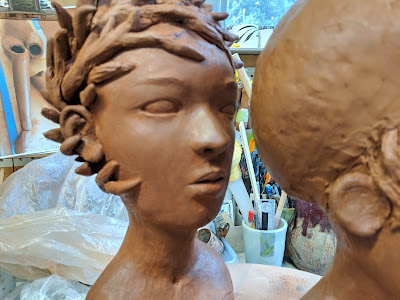Getting the bark on
| As the poet said, 'Only God can make a tree,' probably because it's so hard to figure out how to get the bark on. ~Woody Allen  |
| Tuolumne Meadows Yosemite (inspiration for Between Tree lines series) |
 |
| Lana's Chartreuse Moss Glaze |
 |
| Between Tree Lines (not finished,yet) |
Very often I am asked about my finishes. Most people think that it is paint. So they are surprised to hear that it is nearly all underglazes, oxide washes and some texture glazes. I occasionally add some encaustic, but the piece always has layers of terra sigillata or engobes or slips or underglazes. I have these beautiful pigments from Sinopia. With the pigments,unlike clay materials, the colors are rich and saturated. It is what it is visually. Instant gratification!
Mixing up glazes, the color is normally tan, beige, ecru, green or pink unless using Mason stains. Very dull and very chalky. The magic comes later so there's a lot of future tenses going on with slips and glazes. Although there are misses---I love the thought that the colors become so totally integrated with the piece. It always surprises me when I open the kiln.
Getting lost in the process, layering slips and terra sigillata, mapping out how to get depth and texture...how to use this process to inform the work...fills my day. One of my favorite fussy glazes for texture is Lana Wilson's Chartreuse Moss from her book, Ceramics: Shape and Surface. It looks as if it consisted of dark green chalk grounded up. It comes out anywhere from a brown, mustard crust with bits of lime green shiny chips to a full on curling, bumpy, in your face, here I am chartreuse! It always amazes me and delights me to no end. After years of messing with this glaze I have a better understanding as to how to get more green and less brown. (Or the other way around!)
I used it only on the bottom areas near the sides of Between Tree Lines. The rest of the piece I wanted to maintain some control of the outcome so I washed some areas with copper carbonate/frit 3134 and over that used a porcelain slip with Mason stains in greens and yellows (rutile thrown in,too.)




I have Lana's book somewhere I'm going to have to dig it out, that's a great looking glaze. Your surfaces are wonderful so many tones and colors blended so well.
ReplyDeleteFirst of all 'Between the tree lines' is already fabulous - will you continue to fire her or work on cold finishes at this point?
ReplyDeleteAnd thank you for describing your process so well - it is a magical dance.
And I checked out the Sinopia pigments! WOW what great colors. Do you add them to your terra sigs/slips? I wonder if I could add them to my beeswax --
Great post - thanks Charlene.
Hello Linda---I love Lana's book and the fact she spent a whole year just developing glazes. Now that's focus!
ReplyDeleteHello Judy--- Thank you! "Tree lines" needed more trees attached. I fired them separately and they went in with a different piece. No cold finishes for her! The Sinopia pigments I only use with beeswax or linseed oil. You only need a little bit! I rarely add color to my terra sig for my sculptural work. It is use as a foundation surface and normally just around the face. It is burnished and fired to cone 010 to set it. Then the real fun begins!